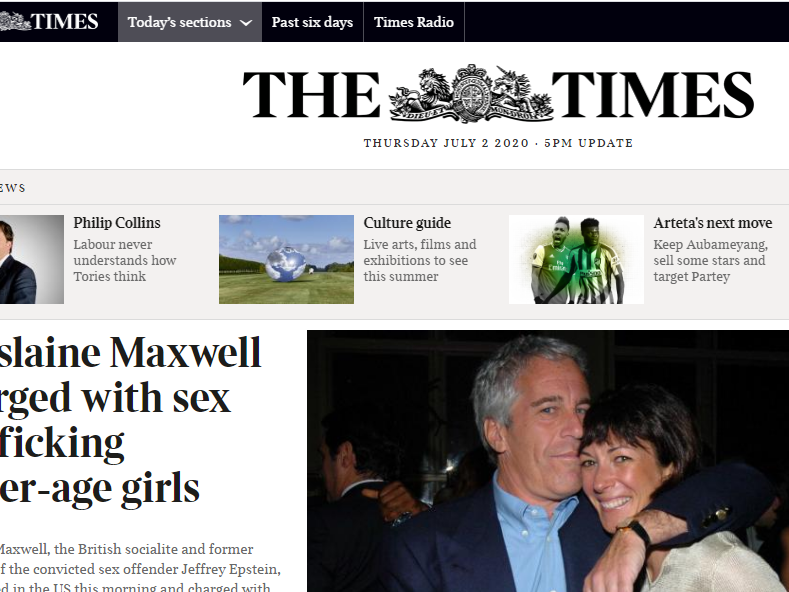
It is now ten years since the Times launched its online subscription model, putting all of its content behind a hard paywall.
Times head of digital Alan Hunter noted on Twitter that in 2010 the consensus was that “nobody would pay” for general interest news.
“Now more than 300,000 do – and paid v free is no longer a debate.”
The Times’ paywall was more ambitious than existing paywalls at titles such as the Financial Times and Wall Street Journal, which at the time allowed limited free access and let casual browsers to view articles via search engines like Google.
We’ve taken a look back at the journey of the past decade and what the Times’ experiment has shown.
2009
News Corp chairman Rupert Murdoch announces his intention to charge for access to all of his newspaper websites by the end of 2010.
Google chief executive Eric Schmidt later poured cold water on the idea, saying it was unlikely a paywall model on general news websites would prosper because of the ubiquity of alternative news sources.
Jonathan Miller, chief digital officer of News Corp, said: “There is a pent up need for this. There has to be a resolution for the free versus pay debate otherwise we cannot afford to pay for things like news bureaus in Kabul.”
2010
Then-Sunday Times editor John Witherow (pictured) admitted the plan was a “big gamble”, but said it was necessary to help meet Times Newspapers’ £100m editorial costs.

He also acknowledged the move risked cutting the Times and Sunday Times “out of the conversation” but said he feared websites that were solely ad-supported would be more vulnerable to economic fluctuations.
And Daniel Finkelstein, who was heading up the paywall project, told Press Gazette: “The success of this is absolutely critical. Everyone should want us to succeed.”
May 2010
A free trial of the new-look Times and Sunday Times websites launched ahead of the paywalled launch.

Sunday Times Hot List section preview in May 2010
Press Gazette’s Dominic Ponsford said they were “much cleaner and crisper in design than existing newspaper websites, largely as a result of the fact that they are no longer designed with search engine optimisation in mind”.
The FT’s Tim Bradshaw also described it as a “slick package, although whether well-bundled, good content is enough of a differentiator from everything on Google News remains to be seen”.
Ponsford noted scepticism from bloggers over the policy of making individual stories effectively invisible to Google and other search engines.
But Finkelstein said: “If there was an easy way of Pritt-sticking our content on the front of each Google search we would do that but there isn’t.”
June 2010
News International “turned off” the old Times Online website after the new separated Times and Sunday Times sites launched. They were initially free for those who registered for about a month before the paywall kicked in.
2 July 2010
The Times and Sunday Times paywalls started charging for access – initially at £1 for a day’s access (the same as the daily paper) or £2 for a week’s subscription to both.
They were the first News International newspapers to do so.
This early package included access to an e-paper version, a culture planner, and daily live debates and discussions. Existing print subscribers received full digital access.
Looking back on this day eight years on, Hunter said: “When we first introduced subscriptions people thought we were crazy… if you look back on it, it seems very logical.”
Post-launch
The Times and Sunday Times lost 90% of their online readers – but this had been predicted by Witherow (and a survey) in advance. He was confident instead that advertisers would be attracted by a “smaller core” of dedicated readers.
Press Gazette’s Ponsford gave his snap critique: his main issues were RSS incapabilities, no author landing pages for the Times’ great writers, no email news alerts, and no in-story links (internal or external) – all niggles that have long been and gone.
But he said the presentation was “amazing”.
The Guardian published a tongue-in-cheek online welcome letter to Times readers who had been locked out by the paywall.
John Crace wrote: “Here at the Guardian we can offer everything you ever wanted from the Times – and more – for nothing”.
November 2010
The Times claimed to have secured just over 50,000 monthly subscribers since the paywall launched.
It said it had achieved more than 105,000 paid-for sales to allow customers to access Times digital content – with around half of these being monthly subscribers and the others a mixture of daily and one-month trial payments. Around three-quarters of this audience was from the UK.
News Corp chief operating officer Chase Carey described the figure as a “great foundation to build on”.
Ponsford said these figures seemed disappointing, “especially compared with the more than 20m unique users a month who used to visit the free-to-air Times Online website”.
“But then again as a long-game strategy perhaps this could still pay off.”
But it did give critics an opportunity to make fun: Tech Crunch called it “operation failure” before it even launched, and appeared to feel vindicated after the first figure was released.
“The number of loyal readers willing to pay for an online subscription to the Times will peak eventually if it hasn’t already,” it said. “Once it does, where will the Times go from there?”
2011
The two titles attracted 79,000 paying digital-only subscribers at the end of February, up from just under 50,000 at the end of October, an increase of almost 60%.
By the end of June they had more than 101,036 monthly digital subscribers– a 28% increase from February.
 Chief executive Rebekah Brooks (pictured) said: “One year on from launch we have proved that people are willing to pay for quality journalism in digital formats.
Chief executive Rebekah Brooks (pictured) said: “One year on from launch we have proved that people are willing to pay for quality journalism in digital formats.
“Many doubted if our digital strategy would be successful, here is unequivocal proof it is moving in that direction.”
By the end of August the figure had risen another 10% to 111,036 compared with a 0.2% fall in The Times’ print circulation during the same period.
The Sun said there were no plans to put its website behind the News International paywall, saying its”mixed” model was working.
2012
In February the Times websites doubled their digital subscription costs to £4 a week for unlimited website access.
Its opinion section soon ventured outside of the paywall with a Tumblr account providing additional coverage and links to other magazines and news sites.
They later eased their all-or-nothing approach to Google, letting Google index headlines and the first couple of sentences of stories for the first time since the paywall went up.
2013
Times rival the Telegraph introduced a metered paywall with a basic rate of £1.99 to access more than 20 website stories a month.
And Times sister title The Sun started charging for website access to readers who wanted to view more than 20 articles a month.
It scrapped the paywall two years later after it attracted around 200,000 paying subscribers but lost ground in terms of overall readership in the last two years.
By October 2013 the Times titles had a digital subscriber base of more than 150,000.
2015
The Times and Sunday Times claimed to have 172,000 digital-only subscribers by March 2015 with a further 229,000 taking either a print subscription or a combined print and digital one.
The subscriber total was said to be up 22,000 year-on-year.
January 2016
By now, it was clear the Times model was a boon as it had begun to break even while the Guardian, which resolutely stuck to its free open journalism model, made its biggest loss ever. (The Guardian has since executed a turnaround plan and broke even in 2018/19. It also takes reader contributions.)
March 2016
Following extensive customer research, the Times switched its digital output from rolling news to three daily online editions at 9am, midday and 5pm.
It was later claimed this led to a huge boost in subscribers of 200% in the first half of 2016 compared to the same period the year before.
The number of subscribers failing to renew was said to be down 4% over the same period.
In June 2016, the Times reached 413,600 print and digital subscribers.
August 2016
The Times opened a breach in its paywall for the first time, allowing registered users to unlock two articles of their choice each week and receive an email highlighting the biggest stories of the day. The idea was to entice readers into signing up for a full subscription by getting a glimpse of the offering.
Times digital director Alan Hunter said this was as close as the title would get to being free online again.
“We don’t use the F word here,” he told Digiday. “It’s a way of experimenting with the subscription funnel. We’ll continue to do experiments like this for a long time.”
2017

London Press Club Awards held at the Corinthia Hotel in Whitehall on 27 April 2017. Picture: Lucy Young
Witherow urged other titles to implement paywalls as the Times and Sunday Times were named daily and Sunday newspaper of the year at the London Press Awards.
“I think the more that do, the better it will be for journalism,” he said.
2018
Digital subscribers outnumbered print for the first time as they rose 20% year-on-year to reach 255,000.
The Times marked 500,000 print and digital subscribers combined.
It also sought to improve engagement by adding comments to the Times mobile app and allow users to see when their favourite journalists were online for discussion.
2019
The Times reached 304,000 digital-only paid subscribers by the end of June after what it described as the most successful year since it put up the paywall.
This remains the latest subscriber figure published by the Times. At this point, a digital-only subscription costs £26 per month (and still does).
The newsbrands also marked some 5m “registered access” users able to read two free articles per week by signing up with an email account.
Witherow (now Times editor) gave a speech shortly before this boasting of the newspaper pursuing its own course 10 years earlier.
“The paywall succeeded because we established a price for digital journalism. We recruited subscribers. We turned a profit. And we continued to invest in the highest quality journalism.
“This might seem obvious now but it is only with hindsight that we see that we were years ahead of our rivals.”
For the 2019 financial year, Times Newspapers reported a pre-tax profits of £3.75m and turnover of £330.2m. It said digital subscriptions remained “key” to its ongoing success.
Email pged@pressgazette.co.uk to point out mistakes, provide story tips or send in a letter for publication on our "Letters Page" blog
